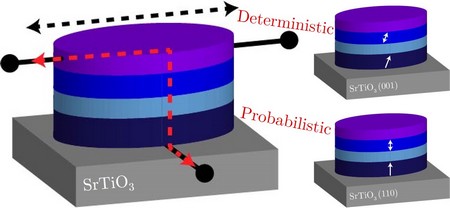New material could create ‘neurons’ and ‘synapses’ for new computers
Classic computers use binary values to perform tasks. By contrast, our brain cells are able to use more values to operate, making them more energy-efficient than computers. This is why scientists are interested in neuromorphic (brain-like) computing. Physicists from the University of Groningen in the Netherlands have used a complex oxide to create elements comparable to the neurons and synapses in the brain using spins, a magnetic property of electrons. Their results were published on 18 May in the journal Frontiers in Nanotechnology.
Although computers can complete straightforward calculations much faster than humans, our brains outperform silicon machines in tasks like object recognition. Furthermore, our brains use less energy than computers. This can partly be explained by the way in which our brains operate: whereas a computer uses a binary system with the values 0 or 1, brain cells can provide more analogue signals with a range of values.

Thin films
The operation of our brains can be simulated by computers, but the basic architecture still relies on a binary system. That is why scientists are looking for ways to expand this system, creating hardware that is more brain-like while also being able to interface with normal computers. ‘One idea is to create magnetic bits that can have intermediate states’, says Tamalika Banerjee, Professor of Spintronics of Functional Materials at the Zernike Institute for Advanced Materials of the University of Groningen. She works in spintronics, which uses a magnetic property of electrons called ‘spin’ to transport, manipulate and store information.
In this study, her PhD student Anouk Goossens, first author of the paper, created thin films of the ferromagnetic metal oxide strontium-ruthenate (SRO), grown on a substrate of strontium titanate oxide. The resulting thin film contains magnetic domains that are perpendicular to the plane of the film. ‘These can be switched more efficiently than in-plane magnetic domains’, explains Goossens. By adapting the growth conditions, it is possible to control the crystal orientation in the SRO. Previously, out-of-plane magnetic domains have been made using other techniques, but these typically require complex layered structures.

Magnetic anisotropy
The magnetic domains can be switched using a current through a platinum electrode on top of the SRO. Goossens: ‘When the magnetic domains are oriented perfectly perpendicular to the film, this switching is deterministic: the entire domain will switch.’ However, when the magnetic domains are slightly tilted, the response is probabilistic: not all the domains are the same, and intermediate values occur when only part of the crystals in the domain have switched.
By choosing variants of the substrate on which the SRO is grown, the scientists can control its magnetic anisotropy. This allows them to produce two different spintronic devices. ‘This magnetic anisotropy is exactly what we wanted’, says Goossens. ‘Probabilistic switching is comparable to how neurons function, while the deterministic switching is more like a synapse.’
The scientists expect that in the future, brain-like computer hardware could be created by combining these different domains in a spintronic device that can be connected to standard silicon-based circuits. Furthermore, probabilistic switching would also allow for stochastic computing, a promising technology that represents continuous values with streams of random bits. Banerjee: ‘We have found a way to control intermediate states, not just for memory but also for computing.’
Reference: A.S. Goossens, M.A.T. Leiviskä and T. Banerjee: Anisotropy and Current Control of Magnetization in SrRuO3/SrTiO3 Heterostructures for Spin-Memristors. Frontiers in Nanotechnology 18 May 2021
| Last modified: | 25 May 2021 2.55 p.m. |
More news
-
13 May 2024
Trapping molecules
In his laboratory, physicist Steven Hoekstra is building an experimental set-up made of two parts: one that produces barium fluoride molecules, and a second part that traps the molecules and brings them to an almost complete standstill so they can...
-
29 April 2024
Tactile sensors
Every two weeks, UG Makers puts the spotlight on a researcher who has created something tangible, ranging from homemade measuring equipment for academic research to small or larger products that can change our daily lives. That is how UG...
-
16 April 2024
UG signs Barcelona Declaration on Open Research Information
In a significant stride toward advancing responsible research assessment and open science, the University of Groningen has officially signed the Barcelona Declaration on Open Research Information.

